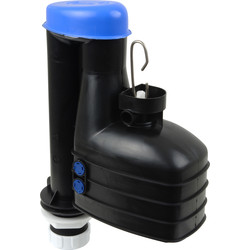- Joined
- 4 Dec 2023
- Messages
- 3
- Reaction score
- 0
- Country

The WC is in a downstairs bathroom. on an outside-type house wall that has my workshop on the other side. There is a outdoors-type gully in the concrete floor of the workshop for the wastes from the bathroom. The end of the overflow pipe from the WC cistern is in same place, and is visible from inside the workshop, so dripping would go into the gully, and would be noticeable..
The water in the trap in the gully gets smelly, as the wastes which run into it are not used often enough. If I clean out the gully trap, the smell goes - but soon returns. This makes the bathroom smelly also - surprising as this may sound! I proved this by temporarily disconnecting the cistern overflow pipe from the section which runs through the wall. I fitted a length of pipe to the existing elbow off the cistern flange and ran this down into a container. I plugged the exposed end of the original pipe where it runs through the wall.
No smell now. The ballvalve is in good order, so no water has accumulated in the container. But the solution creates a flood risk: the ballvalve might fail, and do so seriously enough to direct water into the container at the full mains flow rate.
(BTW, for reasons beyond the scope of this enquiry it is not feasible to solve the problem by changing the low level WC cistern and pan to the modern type which overflows into the pan.)
So I need to revert to the original arrangement, but blocking the smell at the same time!
I can do this by extending the overflow pipe inside the cistern, directing this extension down to reach well below the normal "full" water level. The overflow would still work up to the maximum flow rate that overflow pipe allows. Its "warning pipe" end in the workshop would still be visible.
To make this change I need a flange(?) for the warning pipe hole in the cistern which allows:-
1. The existing connection (short pipe leading to elbow and thence through the wall, blah, blah) on the outside of the cistern, and
2. A similar connection on the inside, or some sort of hopefully neat bodge enabling me to fix a short piece of pipe to the cistern side of the flange. I could then fix a short length of pipe to the flange, plus an elbow, or an elbow straight off the inside end of the flange, and then a down-run of pipe, so as make the entry to the overflow pipe well below normal "full" water level.
So I seem to need some sort of 21 mm overflow-pipe double-ended flange, or a "neat bodge" means of achieving the same result.
Any ideas would be much appreciated!
The water in the trap in the gully gets smelly, as the wastes which run into it are not used often enough. If I clean out the gully trap, the smell goes - but soon returns. This makes the bathroom smelly also - surprising as this may sound! I proved this by temporarily disconnecting the cistern overflow pipe from the section which runs through the wall. I fitted a length of pipe to the existing elbow off the cistern flange and ran this down into a container. I plugged the exposed end of the original pipe where it runs through the wall.
No smell now. The ballvalve is in good order, so no water has accumulated in the container. But the solution creates a flood risk: the ballvalve might fail, and do so seriously enough to direct water into the container at the full mains flow rate.
(BTW, for reasons beyond the scope of this enquiry it is not feasible to solve the problem by changing the low level WC cistern and pan to the modern type which overflows into the pan.)
So I need to revert to the original arrangement, but blocking the smell at the same time!
I can do this by extending the overflow pipe inside the cistern, directing this extension down to reach well below the normal "full" water level. The overflow would still work up to the maximum flow rate that overflow pipe allows. Its "warning pipe" end in the workshop would still be visible.
To make this change I need a flange(?) for the warning pipe hole in the cistern which allows:-
1. The existing connection (short pipe leading to elbow and thence through the wall, blah, blah) on the outside of the cistern, and
2. A similar connection on the inside, or some sort of hopefully neat bodge enabling me to fix a short piece of pipe to the cistern side of the flange. I could then fix a short length of pipe to the flange, plus an elbow, or an elbow straight off the inside end of the flange, and then a down-run of pipe, so as make the entry to the overflow pipe well below normal "full" water level.
So I seem to need some sort of 21 mm overflow-pipe double-ended flange, or a "neat bodge" means of achieving the same result.
Any ideas would be much appreciated!

